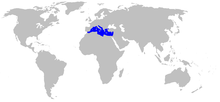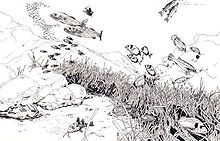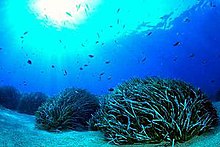Posidonia oceanica
| Posidonia oceanica | |
|---|---|

| |
| Scientific classification | |
| Kingdom: | Plantae |
| Clade: | Tracheophytes |
| Clade: | Angiosperms |
| Clade: | Monocots |
| Order: | Alismatales |
| Family: | Posidoniaceae |
| Genus: | Posidonia |
| Species: | P. oceanica
|
| Binomial name | |
| Posidonia oceanica | |

| |
| Posidonia oceanica range | |
show This article may be expanded with text translated from the corresponding article in Italian. (July 2018) Click [show] for important translation instructions. |
Posidonia oceanica, commonly known as Neptune grass or Mediterranean tapeweed, is a seagrass species that is endemic to the Mediterranean Sea. It forms large underwater meadows that are an important part of the ecosystem. The fruit is free floating and known in Italy as "the olive of the sea" (l'oliva di mare[2]). Balls of fibrous material from its foliage, known as egagropili or Neptune balls,[3] wash up to nearby shorelines.
The Posidonia has a very high carbon absorption capacity, being able to soak up 15 times more carbon dioxide every year than a similar sized piece of the Amazon rainforest.[4]
Taxonomy[]
The genus Posidonia is named after Poseidon, the Greek god of the seas, while oceanica refers to its former wide distribution. Carl Linnaeus gave the first botanical description of this species in Systema Naturae, although the genus was then named Zostera. The APG system (1998) and APG II system (2003) accept the genus as constituting the sole genus in the family Posidoniaceae, which it places in the order Alismatales, in the clade monocots. The Angiosperm Phylogeny Website concludes that the three families Cymodoceaceae, Posidoniaceae and Ruppiaceae form a monophyletic group.[5] Earlier systems classified this genus in the family Potamogetonaceae or in the family Posidoniaceae but belonging to order . It was published in: A. R. Delile, Description de l'Égypte, in 1813.[6]
Description[]
This Section needs additional citations for verification. (August 2019) |

Posidonia oceanica is a flowering plant which lives in dense meadows or along channels in the sands of the Mediterranean. It is found at depths from 1–35 metres (3.3–114.8 ft),[7] according to water clarity. Subsurface rhizomes and roots stabilize the plant while erect rhizomes and leaves reduce silt accumulation.
The leaves are ribbon-like, appearing in tufts of 6 or 7, and up to 1.5 metres (4.9 ft) long.[citation needed] Average leaf width is around 10 millimetres (0.39 in).[citation needed] The leaves are bright green, perhaps turning brown with age, and have 13 to 17 parallel veins. The leaf terminus is rounded or sometimes absent because of damage. Leaves are arranged in groups, with older leaves on the outside, longer and differing in form from the younger leaves they surround.
The rhizome type stems are found in two forms: one growing up to 150 centimetres (59 in) beneath the sand and the other rising above the sand. All stems are approximately 10 millimetres (0.39 in) thick and upright in habit. This arrangement of the rhizomes eventually forms a mat; the surface contains the active parts of the plant, whereas the center is a dense network of roots and decomposing stems.[citation needed]
The flowering plant's common name is Neptune grass.[8]
In 2006 a huge clonal colony of P. oceanica was discovered south of the island of Ibiza and stretches as far south as La Savina and Es Pujols on the island of Formentera. At 8 kilometres (5.0 mi) across, and estimated at around 100,000 years old,[9] it may be one of the largest and oldest clonal colonies on Earth.[10][11][12]
Dead rhizomes with olive-mill waste are used for compost.[13]

Distribution and habitat[]

This species is found only in the Mediterranean Sea, where it is in decline, occupying an area of about 3% of the basin. This corresponds to a surface area of about 38,000 square kilometres (15,000 sq mi). Posidonia grows best in clean waters, and its presence is a marker for lack of pollution.[14] The presence of Posidonia can be detected by the masses of decomposing leaves on beaches. Such plant material has been used for composting, but Italian laws prohibit the use of marine algae and plants for this purpose.[15]
The UNESCO world heritage site around the Balearic Islands of Mallorca and Formentera includes about 55,000 hectares (140,000 acres) of Posidonia oceanica, which has global significance because of the amount of carbon dioxide it absorbs, given the effect of carbon dioxide on climate change. However, the meadows are being threatened by rising temperatures, which slows down its growth, as well as damage from anchors.[16]
Secondary metabolites[]
To date 51 natural products have been reported from P. oceanica, including natural phenols, phenylmethane derivatives, phenylethane derivatives, phenylpropane derivatives and their esters, chalkones, flavonols, , and . Many of the compounds reported for P. oceanica were, however, not detected by appropriate phytochemical methods and some most probably represent artifacts and are not genuine natural products of P. oceanica.[17]
See also[]
- List of long-living organisms
- Largest organisms
References[]

- ^ Pergent, G., Semroud, R., Djellouli, A., Langar, H. & Duarte, C. 2010. Posidonia oceanica. In: IUCN 2012. IUCN Red List of Threatened Species. Version 2012.2. <www.iucnredlist.org>. Downloaded on 9 January 2013.
- ^ "Posidonia oceanica" (PDF) (in Italian). Archived from the original (PDF) on 16 May 2006. Retrieved 8 April 2008.
Dopo essere fecondato, in estate fa crescere e maturare il suo frutto, l’oliva di mare (si chiama così perché ha una forma arrotondata).
- ^ "Seagrass 'Neptune balls' sieve millions of plastic particles from water, study finds". Retrieved 16 January 2021.
Underwater seagrass in coastal areas appear to trap plastic pollution in natural bundles of fibre known as "Neptune balls", researchers have found.
- ^ "Climate change: 'Forever plant' seagrass faces uncertain future". bbc.com. Retrieved 21 March 2021.
- ^ "Alismatales". Mobot.org. Retrieved 11 February 2012.
- ^ "Posidonia oceanica (Linnaeus) Delile 1813 :: Algaebase". www.algaebase.org. Retrieved 19 May 2021.
- ^ Telesca, Luca; Belluscio, Andrea; Criscoli, Alessandro; Ardizzone, Giandomenico; Apostolaki, Eugenia T.; Fraschetti, Simonetta; Gristina, Michele; Knittweis, Leyla; Martin, Corinne S.; Pergent, Gérard; Alagna, Adriana (28 July 2015). "Seagrass meadows ( Posidonia oceanica ) distribution and trajectories of change". Scientific Reports. 5 (1): 12505. doi:10.1038/srep12505. ISSN 2045-2322. PMC 4516961. PMID 26216526.
- ^ "Posidonia oceanis".
- ^ "Portuguese scientists discover world's oldest living organism". Archived from the original on 16 December 2012.
- ^ Ibiza Spotlight (28 May 2006). "Ibiza's Monster Marine Plant". Archived from the original on 27 August 2006. Retrieved 9 May 2007.
- ^ Pearlman, Jonathan (7 February 2012). "'Oldest living thing on earth' discovered". The Telegraph. Archived from the original on 7 February 2012. Retrieved 11 February 2012.
- ^ Arnaud-Haond, Sophie; Duarte, Carlos M.; Diaz-Almela, Elena; Marbà, Núria; Sintes, Tomas; Serrão, Ester A.; Bruun, Hans Henrik (2012). "Implications of Extreme Life Span in Clonal Organisms: Millenary Clones in Meadows of the Threatened Seagrass Posidonia oceanica". PLOS ONE. 7 (2): e30454. Bibcode:2012PLoSO...730454A. doi:10.1371/journal.pone.0030454. PMC 3270012. PMID 22312426.
- ^ "Posidonia – an overview | ScienceDirect Topics". www.sciencedirect.com. Retrieved 19 May 2021.
- ^ Pergent-Martini, Christine (1998). "Posidonia oceanica: a biological indicator of past and present mercury contamination in the mediterranean sea". Marine Environmental Research. 45 (2): 101–111. doi:10.1016/S0141-1136(97)00023-8.
- ^ "Decreto Legislativo 29 aprile 2010, n. 75" (PDF). Gazzetta Ufficiale della Repubblica Italiana. Supplemento ordinario n. 106/L (121). 26 May 2010. Archived from the original (PDF) on 24 February 2014.
- ^ McGrath, Matt (13 March 2021). "Climate change: 'Forever plant' seagrass faces uncertain future". BBC News. Retrieved 20 April 2021.
- ^ Heglmeier, A; Zidorn, C (October 2010). "Secondary metabolites of Posidonia oceanica". Biochemical Systematics and Ecology. Amsterdam. 38 (5): 964–70. doi:10.1016/j.bse.2010.07.001. ISSN 0305-1978.
External links[]
![]() Media related to Posidonia oceanica at Wikimedia Commons
Media related to Posidonia oceanica at Wikimedia Commons
- Posidonia oceanica – MondoMarino.net
- Ibiza's Monster Marine Plant. Ibiza Spotlight, 28 May 2006.
- Project LIFE SEPOSSO LIFE SEPOSSO – Supporting Environmental governance for the POSidonia oceanica Sustainable transplanting Operations.
- IUCN Red List least concern species
- Posidonia
- Biota of the Adriatic Sea
- Biota of the Mediterranean Sea
